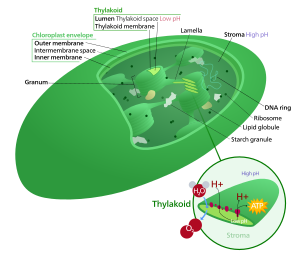Chloroplast
| Live, reproduce, die Biology |
| Life as we know it |
| Divide and multiply |
| Great Apes |
Chloroplasts are the specialised organelles found in almost all plant species and are the means by which photosynthesis occurs. All of the green structures in plants, including stems and unripened fruit, contain chloroplasts, but the majority of photosynthesis activity in most plants occurs in the leaves. On the average, the chloroplast density on the surface of a leaf is about one-half million per square millimeter.
Varieties[edit]
Chloroplasts are one of several different types of plastids, plant cell organelles that are involved in energy storage and the synthesis of metabolic materials. The colorless leucoplasts, for instance, are involved in the synthesis of starch, oils, and proteins. Yellow-to-red colored chromoplasts manufacture carotenoids, and the green colored chloroplasts contain the pigments chlorophyll a and chlorophyll b, which are able to absorb the light energy needed for photosynthesis to occur. All plastids develop from tiny organelles found in the immature cells of plant meristems (undifferentiated plant tissue) termed proplastids, and those of a particular plant species all contain copies of the same circular genome. The disparities between the various types of plastids are based upon the needs of the differentiated cells they are contained in, which may be influenced by environmental conditions, such as whether light or darkness surrounds a leaf as it grows.
Structure[edit]
The ellipsoid-shaped chloroplast is enclosed in a double membrane and the area between the two layers that make up the membrane is called the intermembrane space. The outer layer of the double membrane is much more permeable than the inner layer, which features a number of embedded membrane transport proteins. Enclosed by the chloroplast membrane is the stroma, a semi-fluid material that contains dissolved enzymes and comprises most of the chloroplast's volume. Since, like mitochondria, chloroplasts possess their own genomes (DNA), the stroma contains chloroplast DNA and special ribosomes and RNAs as well. In higher plants, lamellae, internal membranes with stacks (each termed a granum) of closed hollow disks called thylakoids, are also usually dispersed throughout the stroma. The numerous thylakoids in each stack are thought to be connected via their lumens (internal spaces).
Functionality[edit]
Light travels as packets of energy called photons and is absorbed in this form by light-absorbing chlorophyll molecules embedded in the thylakoid disks. When these chlorophyll molecules absorb the photons, they emit electrons, which they obtain from water (a process that results in the release of oxygen as a byproduct). The movement of the electrons causes hydrogen ions to be propelled across the membrane surrounding the thylakoid stack, which consequently initiates the formation of an electrochemical gradient that drives the stroma's production of adenosine triphosphate (ATP). ATP is the chemical energy "currency" of the cell that powers the cell's metabolic activities. In the stroma, the light-independent reactions of photosynthesis, which involve carbon fixation, occur, and low-energy carbon dioxide is transformed into a high-energy compound like glucose.
Evolutionary Hypothesis[edit]
Plant cells are remarkable in that they have two organelles specialized for energy production: chloroplasts, which create energy via photosynthesis, and mitochondria, which generate energy through respiration, a particularly important process when light is unavailable. Like the mitochondrion, the chloroplast is different from most other organelles because it has its own DNA and reproduces independently of the cell in which it is found; an apparent case of endosymbiosis. Scientists hypothesize that millions of years ago small, free-living prokaryotes were engulfed, but not consumed, by larger prokaryotes, perhaps because they were able to resist the digestive enzymes of the engulfing organism. According to DNA evidence, the eukaryotic organisms that later became plants likely added the photosynthetic pathway in this way, by acquiring a photosynthetic bacterium as an endosymbiont.
As suggested by this hypothesis, the two organisms developed a symbiotic relationship over time, the larger organism providing the smaller with ample nutrients and the smaller organism providing ATP molecules to the larger one. Eventually, the larger organism developed into the eukaryotic cell, the smaller organism into the chloroplast. Nonetheless, there are a number of prokaryotic traits that chloroplasts continue to exhibit. Their DNA is circular, as it is in the prokaryotes, and their ribosomes and reproductive methods (binary fission)![]() are more like those of the prokaryotes.
are more like those of the prokaryotes.

